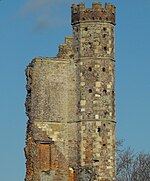Havant New railway station
Disused railway stations in HampshireFormer London and South Western Railway stationsRailway stations in Great Britain closed in 1859Railway stations in Great Britain opened in 1859South East England railway station stubs ... and 1 more
Use British English from February 2018
Havant New was a temporary terminus between Havant and Rowlands Castle on the Portsmouth Direct Line: a temporary platform, erected by the L&SWR who were granted permission to run all trains along the line by its independent venture owners, but which did not reach Portsmouth, which started a dispute with the LB&SCR which owned the only railway south of Havant.
Excerpt from the Wikipedia article Havant New railway station (License: CC BY-SA 3.0, Authors).Havant New railway station
Geographical coordinates (GPS) Address Nearby Places Show on map
Geographical coordinates (GPS)
| Latitude | Longitude |
|---|---|
| N 50.857777777778 ° | E -0.96944444444444 ° |
Address
PO9 2QU
England, United Kingdom
Open on Google Maps








